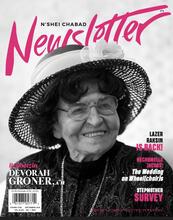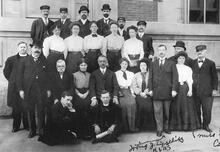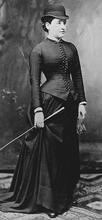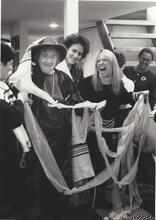Faige Teitelbaum
When Faige Teitelbaum married Satmar rebbe Rabbi Joel Teitelbaum in 1936, she became the Satmar rebbetzin, in which capacity she was very active in charitable activities, collecting and distributing money to needy Jewish people around the globe. As her husband aged, Teitelbaum became a recognized conduit to the rebbe, controlling access to her ill husband and helping to make major decisions facing the Satmar community. After the rebbe died, the community was divided; a majority followed the new Satmar rebbe, but a small minority remained loyal to Teitelbaum’s memory of her late husband. She thus became a spiritual leader in her own right and was the only woman in the Hasidic world to function as a de facto rebbe and leader.
Life as the Satmar Rebbetzin
Faige Teitelbaum was the wife of the late Satmar rebbe, Rabbi Joel Teitelbaum (died 1979). She was a leader of the Satmar Hasidic community and often performed the role of a Hasidic rebbe. In this powerful role, she was undoubtedly the best-known woman in the Hasidic world.
Faige (Shapiro) Teitelbaum was born on April 19, 1912, in Czenstichov, Poland, the daughter of a well-known Polish Hasidic leader, Rabbi Avigdor Shapiro, a scion of the Kosnitz Hasidic dynasty. In 1936, she married Rabbi Joel Teitelbaum, thereby becoming the Satmar (Yiddish) Rabbi's wife; title for a learned or respected woman.rebbetzin [traditional title given to the wife of an orthodox rabbi]. Rabbi Teitelbaum’s first wife, with whom he had three daughters, had died several years earlier. The Teitelbaums were rescued from the Nazi regime of Hungary in 1944 and relocated to the Williamsburg section of Brooklyn, New York, in 1947.
While the outside world best knows the Satmar Hasidim for their rigid opposition to Israel and political Zionism, the Satmar community has developed a vast institutional structure, composed of religious, educational, and social welfare institutions. While the chief centers of Satmar are in Monroe, New York, and Williamsburg, other Satmar communities are found in Borough Park, Brooklyn; Monsey, New York; Lakewood, New Jersey; Montreal; London; Buenos Aires; Melbourne; Vienna; Antwerp; and a number of cities in Israel.
Teitelbaum was particularly active in various charitable activities in the Satmar community. She collected and distributed enormous amounts of money to Jewish people in need around the globe. Because of her particular interest in assisting brides and young mothers, she was instrumental in establishing several rest homes for women with young children. These hostels were located in the metropolitan New York area and were open to all Orthodox mothers at little or no cost. Because of Teitelbaum’s charitable work, many followers of the Satmar rebbe regarded her as a saintly woman in her own right.
Becoming a Spiritual Leader
As her husband aged and his health deteriorated, Teitelbaum came to be regarded by her husband’s followers as a conduit to their rebbe. With a small group of loyal assistants, she controlled access to her ill husband and often had a strong say in major decisions regarding the Satmar community.
Faige had no children and following Joel Teitelbaum’s death in 1979, many Satmar Hasidim regarded Teitelbaum as a spiritual leader and as a symbol to preserve the memory of their beloved rebbe. Hasidim refused to accept the authority of the new Satmar rebbe, Rabbi Moses Teitelbaum, a nephew of the late rabbi. They firmly believed that no new rebbe was necessary at this point and were supported in their belief by Joel Teitelbaum’s chief administrative aide, Rabbi Joseph Ashkenasi. Rather, Faige Teitelbaum, with a group of loyal male aides, would speak for the dead rebbe and control access to his grave site in Kiryas Joel [Joel’s village], the autonomous Satmar village in Monroe, New York.
After 1979, the leadership struggle in the community continued. While Rabbi Moses Teitelbaum retained control of the majority of the Satmar people, a small group called B’nai Joel [children of Joel] remained loyal to Teitelbaum’s memory of her late husband. These groups clashed, often violently, chiefly in Kiryas Joel. At the same time, Teitelbaum continued her charitable activities, distributing large amounts of money in the United States and Israel. Supporters and admirers regarded Teitelbaum as a Hasidic leader and a sort of rebbe in her own right. Many Satmar Hasidim regularly petitioned her for blessings and advice. Teitelbaum was thus unique in the post–World War II period, as the only woman in the Hasidic world who functioned de facto as a Hasidic rebbe and leader.
While modern society might regard Teitelbaum’s powerful position as a throwback to leadership roles played by women in the nineteenth and early twentieth centuries, she was clearly a major influence in her own society. Revered in the Hasidic community in general and the Satmar community in particular, Feige Teitelbaum died on June 2, 2001 at Mount Sinai Hospital in Manhattan.
Alpert, Zalman. “Satmar Rebbe: Joel Teitelbaum.” In Jewish-American History and Culture: An Encyclopedia (1992): 562–563.
Kranzler, George. Hasidic Williamsburg: A Contemporary American Hasidic Community. N.p.: Jason Aronson., 1995.
Mintz, Jerome. Hasidic People: A Place in the New World. Cambridge: Harvard University Press, 1992.
Rubin, Israel. Satmar: An Island in the City. Chicago: Quadrangle Books, 1972.
Rockove, Moshe. “Rebbetzin Alta Feiga Teitelbaum.” Dei’ah VeDibur, August 8, 2001.
Martin, Douglas. “Faiga Teitelbaum, 89, a Power Among the Satmar Hassidim. The New York Times, June 13, 2001, 15C.








